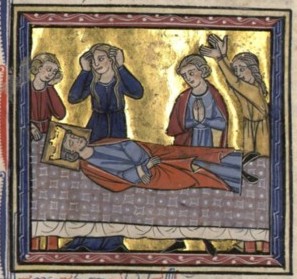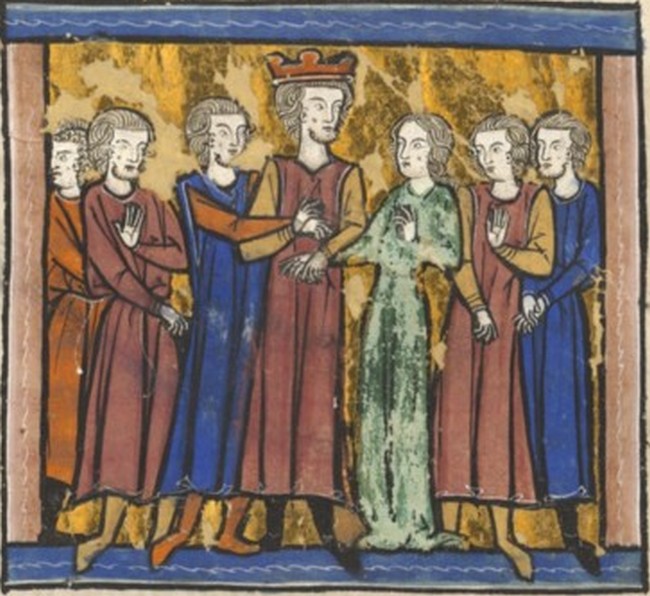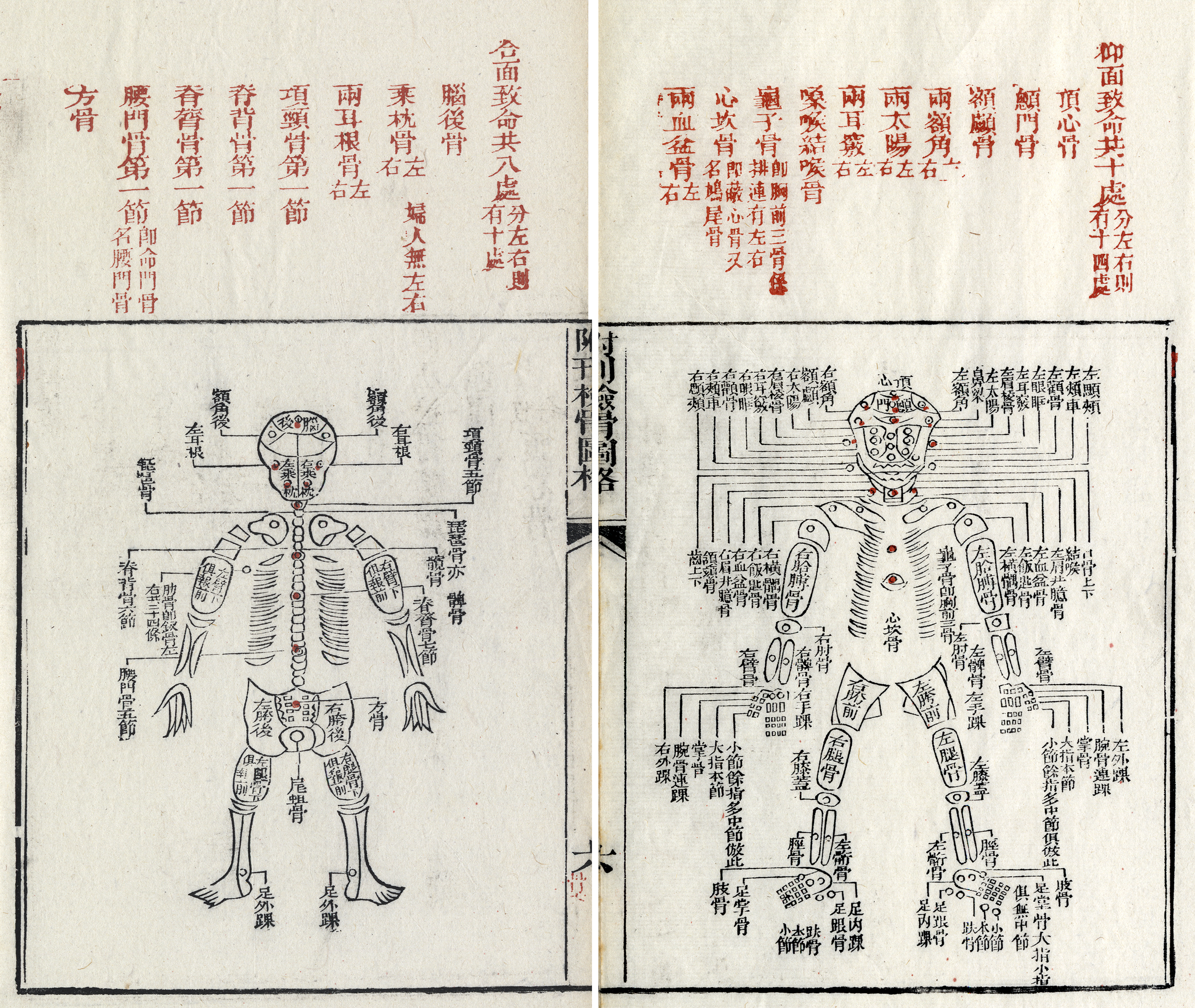|
1186
Year 1186 (Roman numerals, MCLXXXVI) was a common year starting on Wednesday (link will display the full calendar) of the Julian calendar. Events * January 27 – Constance of Sicily marries Henry (the future Henry VI, Holy Roman Emperor). * John the Chanter becomes Bishop of Exeter. * The Byzantine Empire recognizes the independence of Second Bulgarian Empire, Bulgaria and Grand Principality of Serbia, Serbia. * Joscius, Archbishop of Tyre, Joscius becomes Roman Catholic Archdiocese of Tyre, Archbishop of Tyre. * Jayavarman VII, the king of Cambodia, founds the temple of Ta Prohm. * After the death of the child-king Baldwin V, his mother succeeds him as Sibylla of Jerusalem, and appoints her disfavoured husband Guy de Lusignan king consort. This comes as a shock to Jerusalem's court, who had earlier forced the possible future Queen into promising that should she become so, she would not appoint him the title. * The first nunnery is inaugurated in Iceland, the Kirkjubæjar ... [...More Info...] [...Related Items...] OR: [Wikipedia] [Google] [Baidu] |
Sibylla Of Jerusalem
Sibylla ( fro, Sibyl; 1159 – 25 July 1190) was Queen of Jerusalem from 1186 to 1190. She reigned alongside her husband Guy of Lusignan, to whom she was unwaveringly attached despite his unpopularity among the barons of the Kingdom of Jerusalem. Sibylla was the eldest daughter of King Amalric and the only daughter of Agnes of Courtenay. Her father died in 1174, making her heir presumptive to her younger brother, King Baldwin IV. When it became clear that 13-year-old Baldwin had contracted leprosy, the matter of Sibylla's marriage became urgent. The regent, Count Raymond III of Tripoli, arranged for her to marry William Longsword of Montferrat in late 1176, but William left her a pregnant widow, and in possession of the County of Jaffa and Ascalon, in 1177. Shortly after giving birth to a son, King Baldwin V, Baldwin, Sibylla came to be associated with her brother in public acts, thereby being designated as next in line to the throne. Sibylla's second marriage, to Guy of Lus ... [...More Info...] [...Related Items...] OR: [Wikipedia] [Google] [Baidu] |
Guy De Lusignan
Guy of Lusignan (c. 1150 – 18 July 1194) was a French Poitevin knight, son of Hugh VIII of Lusignan and as such born of the House of Lusignan. He was king of Jerusalem from 1186 to 1192 by right of marriage to Sibylla of Jerusalem, and King of Cyprus from 1192 to 1194. Having arrived in the Holy Land (where his brother Aimery of Lusignan was already prominent) at an unknown date, Guy was hastily married to Sibylla in 1180 to prevent a political incident within the kingdom. As the health of his brother-in-law, Baldwin IV of Jerusalem, deteriorated, Guy was appointed by Sibylla as regent for his stepson, Baldwin V of Jerusalem. Baldwin IV died in 1185, followed shortly by Baldwin V in 1186, leading to the succession of Sibylla and Guy to the throne. Guy's reign was marked by increased hostilities with the Ayyubids ruled by Saladin, culminating in the Battle of Hattin in July 1187—during which Guy was captured—and the fall of Jerusalem itself three months later. Followin ... [...More Info...] [...Related Items...] OR: [Wikipedia] [Google] [Baidu] |
Henry VI, Holy Roman Emperor
Henry VI (German: ''Heinrich VI.''; November 1165 – 28 September 1197), a member of the Hohenstaufen dynasty, was King of Germany ( King of the Romans) from 1169 and Holy Roman Emperor from 1191 until his death. From 1194 he was also King of Sicily. Henry was the second son of Emperor Frederick Barbarossa and Beatrice I, Countess of Burgundy. Well educated in the Latin language, as well as Roman and canon law, Henry was also a patron of poets and a skilled poet himself. In 1186 he was married to Constance of Sicily, the posthumous daughter of the Norman king Roger II of Sicily. Henry, stuck in the Hohenstaufen conflict with the House of Welf until 1194, had to enforce the inheritance claims by his wife against her nephew Count Tancred of Lecce. Henry's attempt to conquer the Kingdom of Sicily failed at the siege of Naples in 1191 due to an epidemic, with Empress Constance captured. Based on an enormous ransom for the release and submission of King Richard I of England, he ... [...More Info...] [...Related Items...] OR: [Wikipedia] [Google] [Baidu] |
Second Bulgarian Empire
The Second Bulgarian Empire (; ) was a medieval Bulgarians, Bulgarian state that existed between 1185 and 1396. A successor to the First Bulgarian Empire, it reached the peak of its power under Tsars Kaloyan of Bulgaria, Kaloyan and Ivan Asen II before gradually being conquered by the Ottoman Empire, Ottomans in the late 14th century. Until 1256, the Second Bulgarian Empire was the dominant power in the Balkans, defeating the Byzantine Empire in several major battles. In 1205, Emperor Kaloyan defeated the newly established Latin Empire in the battle of Adrianople (1205), Battle of Adrianople. His nephew Ivan Asen II defeated the Despotate of Epiros and made Bulgaria a regional power again. During his reign, Bulgaria spread from the Adriatic Sea, Adriatic to the Black Sea and the economy flourished. In the late 13th century, however, the Empire declined under constant invasions by Mongols, Byzantine Empire, Byzantines, Hungarians, and Serbia in the Middle Ages, Serbs, as well as i ... [...More Info...] [...Related Items...] OR: [Wikipedia] [Google] [Baidu] |
Constance Of Sicily
Constance I ( it, Costanza; 2 November 1154 – 27 November 1198) was reigning Queen of Sicily from 1194–98, jointly with her spouse from 1194 to 1197, and with her infant son Frederick II, Holy Roman Emperor, in 1198, as the heiress of the Norman kings of Sicily. She was also Holy Roman Empress and later Dowager by marriage to Henry VI, Holy Roman Emperor. When she was young, as the sole heir to the throne of Sicily, she didn't marry until she was 30 because of an ominous prophecy; shortly after becoming empress she was involved in the succession war against her illegitimate nephew King Tancred of Sicily for the Sicilian throne, during which, rarely for an empress, she was captured during such an offensive campaign, though finally without danger she escaped. In the history of Holy Roman Empire only two empresses had ever been captured, the other being her mother-in-law Empress Beatrice. Shortly before ascending the Sicilian throne, at the advanced age of 40, she gave bir ... [...More Info...] [...Related Items...] OR: [Wikipedia] [Google] [Baidu] |
Urraca Of Castile, Queen Of Portugal
Urraca of Castile (1186/28 May 1187 – 3 November 1220) was a daughter of Alfonso VIII of Castile and Eleanor of England. Her maternal grandparents were Henry II of England and Eleanor of Aquitaine. Life Urraca was originally considered as a prospective bride for Louis VIII of France, but Eleanor of Aquitaine objected to her name (Urraca means ''magpie'' in Castilian), preferring the Castilian name of Urraca's sister Blanche, Blanca. In 1206, Urraca married twenty-one-year-old Afonso II of Portugal, who was the "infante", the intended heir to the throne. In 1212, her husband became king and she became queen. Afonso II indicated in his will in 1214 that Urraca should be the regent for his heir should he pre-decease her. However, she died before him at a relatively young age in 1220. Urraca was buried at the Alcobaça Monastery. Issue *Sancho II of Portugal *Afonso III of Portugal * Eleanor of Portugal, Queen of Denmark * Fernando, Lord of Serpa References , - ... [...More Info...] [...Related Items...] OR: [Wikipedia] [Google] [Baidu] |
Kirkjubæjar Abbey
Kirkjubæjar Abbey (Icelandic: ''Kirkjubæjarklaustur''), in operation from 1186 until the Icelandic Reformation, was a monastery in Iceland of nuns of the Order of St. Benedict. It was located at Kirkjubæjarklaustur. Iceland had nine religious communities before the Reformation, two of which were monasteries of nuns, of which this is the first and oldest. In contrast to the other women's monastery in Iceland, Reynistaðarklaustur (1295–1563), which was placed under the authority of the Bishop of Hólar, at Kirkjubæjar Abbey the Abbess was left in full authority over the community, free of episcopal oversight. History The Abbey was founded in 1186. The first abbess was Halldóra Eyjólfsdóttir, who died in 1210. The abbey was regarded as a center of culture and literature. In the mid-14th-century, the abbey was given a name of being in opposition to the Pope. A nun named Karin or Kristin held what was heretic sermons in the convent. She was put on trial on charges of having ... [...More Info...] [...Related Items...] OR: [Wikipedia] [Google] [Baidu] |
Ta Prohm
Ta Prohm ( km, ប្រាសាទតាព្រហ្ម, UNGEGN: , ALA-LC: ; "Ancestor Brahma") is the modern name of the temple in Siem Reap, Cambodia, built in the Bayon style largely in the late 12th and early 13th centuries and originally called Rajavihara ( km, រាជវិហារ, UNGEGN: , ALA-LC: ; "Royal Monastery"). Located approximately one kilometre east of Angkor Thom and on the southern edge of the East Baray, it was founded by the Khmer King Jayavarman VIIHigham, C., 2001, The Civilization of Angkor, London: Weidenfeld & Nicolson, Higham, C., 2014, Early Mainland Southeast Asia, Bangkok: River Books Co., Ltd., as a Mahayana Buddhist monastery and university. Unlike most Angkorian temples, Ta Prohm is in much the same condition in which it was found: the photogenic and atmospheric combination of trees growing out of the ruins and the jungle surroundings have made it one of Angkor's most popular temples with visitors. UNESCO inscribed Ta Prohm on ... [...More Info...] [...Related Items...] OR: [Wikipedia] [Google] [Baidu] |
Song Ci
Song Ci (; 1186–1249) was a Chinese physician, judge, forensic medical scientist, anthropologist, and writer of the Southern Song dynasty. He is most well known for being the world's first forensic entomologist, having recorded his experience examining bodies for judicial cases in the ''Collected Cases of Injustice Rectified'' (''Xi Yuan Ji Lu''). Song Ci was born into a bureaucrat family in Jianyang (in modern Fujian Province). He served as a presiding judge in the high courts of the Song dynasty for several terms. During his post at a criminal court in Hunan Province, Song Ci personally examined the crime scenes each time he encountered a difficult case of homicide or physical assault. Song Ci combined historical cases of forensic science with his own experiences and wrote the book ''Collected Cases of Injustice Rectified'', the oldest known evidence of forensic entomology, with an eye to avoiding miscarriages of justice. The book was esteemed by generations of forensic s ... [...More Info...] [...Related Items...] OR: [Wikipedia] [Google] [Baidu] |
Seljuki Khatun
Seljuki Khatun ( ar, سلجوقي خاتون) or Saljuqi Khatun was a Seljuk Turkish princess of Rum, daughter of sultan Kilij Arslan II and wife of Abbasid caliph al-Nasir. Biography Seljuki Khatun was a daughter of sultan of Rum, Kilij Arslan II. She had eleven brothers,including future sultan Kaykhusraw I, and two older sisters. She spent her childhood at her father's court in Konya. She married Caliph al-Nasir () in 1186. Right after her betrothal to him, he sent an escort to bring her to Baghdad Baghdad (; ar, بَغْدَاد , ) is the capital of Iraq and the second-largest city in the Arab world after Cairo. It is located on the Tigris near the ruins of the ancient city of Babylon and the Sassanid Persian capital of Ctesiphon ..., consummated the marriage, and gave her priceless jewels and gifts. Seljuki died two years later in 1188. Caliph al-Nasir was so grief-stricken at her passing that he could not eat or drink for days. For many years her house was left ... [...More Info...] [...Related Items...] OR: [Wikipedia] [Google] [Baidu] |
Al-Nasir
Abu'l-Abbas Ahmad ibn al-Hassan al-Mustadi' ( ar, أبو العباس أحمد بن الحسن المستضيء) better known by his laqab Al-Nasir li-Din Allah ( ar, الناصر لدين الله; 6 August 1158 – 5 October 1225) or simply as Al-Nasir was the Abbasid caliph in Baghdad from 1180 until his death. His laqab literally can mean ''The One who Gives Victory to the Religion of God''. He continued the efforts of his grandfather Al-Muqtafi in restoring the caliphate to its ancient dominant role and achieved a surprising amount of success as his army even conquered parts of Iran. According to the historian, Angelika Hartmann, Al-Nasir was the last ''effective Abbasid'' Caliph. In addition to his military success Al-Nasir built many monuments in Baghdad that are still standing such as Zumurrud Khatun Mosque and Mausoleum. Biography Al-Nasir was the son of Caliph al-Mustadi and a Turkish ''umm walad'' called ''Zumurrud'' (Emerald). His reign was unusual for the rise of t ... [...More Info...] [...Related Items...] OR: [Wikipedia] [Google] [Baidu] |
Roman Catholic Archdiocese Of Tyre
The Roman Catholic Archdiocese of Tyre was an archbishopric in the Kingdom of Jerusalem. Background The See of Tyre was the most prestigious Diocese, archbishopric under the authority of the Patriarch of Antioch, patriarchs of Antioch from the 5th century. The archbishops had more than a dozen suffragan bishops, suffragans, including the bishops of Acre, Beirut, Byblos, Sidon, Tripoli and Tortosa. The crusaders captured Tortosa (now Tartus in Syria) in 1102, Byblos in 1103, and Tripoli, Lebanon, Tripoli in 1109. In the late 1170s, William of Tyre wrote that Bernard of Valence, the Latin Patriarch of Antioch, had soon appointed Latin bishops to the three bishoprics. Documents written in the early 12th century did not refer to the bishops of the three dioceses, suggesting that the three sees, all located in the newly established crusader County of Tripoli, were actually left vacant. After King Baldwin I of Jerusalem captured Sidon and Beirut in 1110, Ghibbelin of Arles, the Latin Pa ... [...More Info...] [...Related Items...] OR: [Wikipedia] [Google] [Baidu] |






